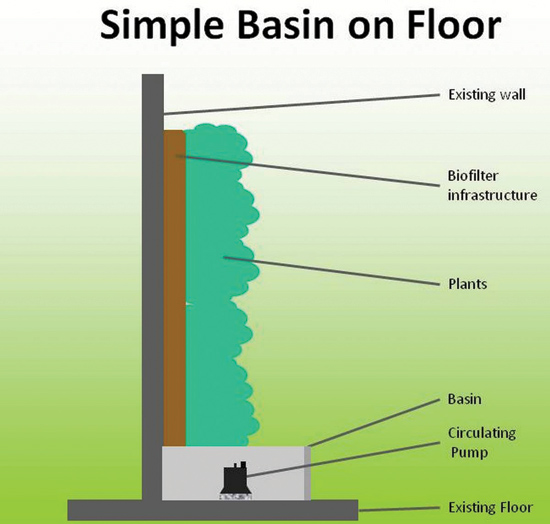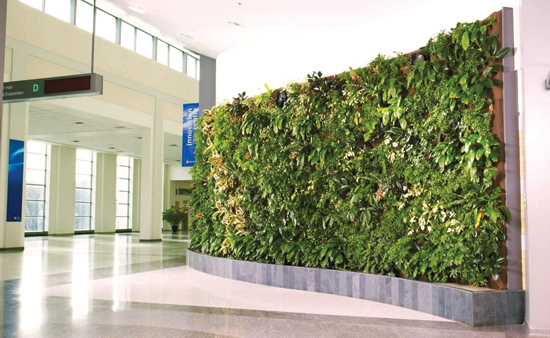Hydroponic Living Plant Walls
Hydroponic Rooting Media
The critical component of hydroponic living plant walls is the rooting media. This material must be inert and free from contaminants that could interfere with plant growth. The material must allow water to flow freely while maintaining good air spaces. The main advantage of the hydroponic media is that it retains its characteristics under the very intensive management seen on plant walls. Despite the very rapid and extensive flush of water down the wall, the internal structure of the hydroponic media will need to hold its structure for many years. A number of hydroponic living wall rooting media are now available. Most providers use either rockwool, felt, or a mat material as a rooting substrate.
 |
 |
Hydroponic living plant walls are based on vertical applications of traditional hydroponic systems but with particular attention to the growing media and irrigation methods used. Images courtesy of Nedlaw Living Walls, Inc. |
Because of its use in traditional agriculture venues, more is known about the cultivating of plants in rockwool than felt and matting. Rockwool has an advantage in that it has a substantial water holding capacity per unit of surface area. However, when saturated with water, this means that rockwool is quite heavy with weights of the rooting media of 20 pounds per square foot (100 kg/square meter); this is four or five times the operating weight of wet matting or felt. Therefore rockwool requires a substantial support system. Matting and felt are produced as sheets which allows for less restrictions on root growth and more uniform water flow down its face. Also, because of the lower weight of the felt and mat-based systems, less structure is required to support the material.
Many of the considerations in selecting the hydroponic media for vertical gardens are the same as far traditional hydroponic systems (see for example: http://www.growstone.com/2012/01/maximum-yield-april-2009/). Basically, the media needs a good bulk density to pore space ratio meaning that the media needs to have a great deal of internal space available for both the water and air which are needed for plant growth. This available space can be further refined into the ratio of water holding capacity to available air spaces—i.e. how much of the internal structure is occupied by water and air under normal operating conditions. The media must be capable of holding a good reservoir of water without sacrificing available air channels and allow oxygen to get to the roots. The porosity not only allows good air movement but also good drainage when water is present in excess as happens during watering cycles.
The other important consideration with using material with a low bulk density is the ease of shipping and installation. During installation, hydroponic rooting material frequently has weights of less than an ounce per quart (several grams per liter) of volume compared to the soil mixes that are typically on the order of a pound or more per quart (hundreds of grams per liter). This is important if the installation is taking place several stories up in the air.
The rooting media must also be benign. This is required first from the basis of toxicity to the plants and other building occupants. The use of the material in the built environment adds a higher degree of concern about the toxicity of the material than typically encountered under “normal” hydroponic situations. This relates to the entire life cycle of the material, under the complete range of conditions and situations found in the built environment. The media should also be inert in terms of the nutrient balance of the plants. The media should never absorb or release nutrients circulating in the irrigation water. This is managed by selecting media with low cation (positively charged ion) exchange capacity (CEC). With low CEC, the manager knows that all the fertilizer that goes into the system is being available to the plants and not binding to the rooting medium. Remember, the best hydroponic rooting media is simply a support system for the plant's roots.
The last factor of concern for the media is longevity. Many organic media such as coir (coconut fiber) are available and work well but simply do not have the life expectancy needed. The material has good water holding capacity and porosity but is broken down within a few months of installation. Mat-based rooting media has been installed in some biofilters for close to 10 years and still meets the performance specifications.
Hydroponic rooting media used in living plant walls must meet all of these criteria and those that are unique to the vertical plant systems. Unlike soil which requires containment systems, mat and felt hydroponic rooting media is self-supporting. The media does not require a container to be used on a vertical surface. The mat and felt material can be installed as continuous sheets which covers a substantial vertical height of the wall. The sheets can be overlapped to ensure adequate hydraulic conductivity between sheets. The height of the single sheet (close to 4 feet or 1.2 meters) minimizes the transitions and the overlap of the sheets minimizes the possibility of perched water tables within the wall. Horizontal spread of water is not truncated by the presence of vertical walls of the containers. Alternatively, the lack of horizontal “baffles” in the hydroponic could lead to the cohesive forces of the water pulling the flowing water into streams. These channels of water would only flow through narrow sections of the media while the rest of the wall would go dry.
Selection of media with an adequate grain can further influence the formation of water channels. The grain is determined by the alignment of the media's fibers. Most of the fibers in rockwool run parallel to its long axis, so installing the pieces so the grain is perpendicular to the flow of water and will discourage channelling and give more uniform water horizontal distribution but may encourage formation of perched water tables.
Mat rooting material is a spun polyester mat held together with epoxy resins that has a random alignment of fibers which works to disseminate any channels. The channelling of the water is most pronounced when the water passes through dry media because as with soil, it is difficult to initially wet the media. With experience, it has been found that once wet, the roots of the plants acts as baffles and largely stop the formation of water channels giving good horizontal spread of water.
Irrigation of Living Plant Walls
With the growing media established, the focus now turns to irrigation of the plants. The simplest type of irrigation system is an open loop type design. With this design, water is released to the top of the wall (typically from a domestic cold water supply) and flows down the wall to a drain at the bottom. The water comes in contact with the wall once and is shuttled to the drain. Nutrients are typically injected into the irrigation water or more rarely, integrated to the rooting substrate. Either way, the nutrients that have dissolved into the water and have not been taken up by the plants are washed down the drain along with the water. This approach is extremely consumptive in resources. It places very high demands on the water usage and the wastewater system both in terms of volume of effluent generated and nutrient loading of the system. For this reason all but the smallest plant walls should not have open loop irrigation designs.
 |
 |
A simple closed loop hydroponic living plant wall system uses a basin to collect and store water that can be re-circulated to the plants. Images courtesy of Nedlaw Living Walls, Inc. |









